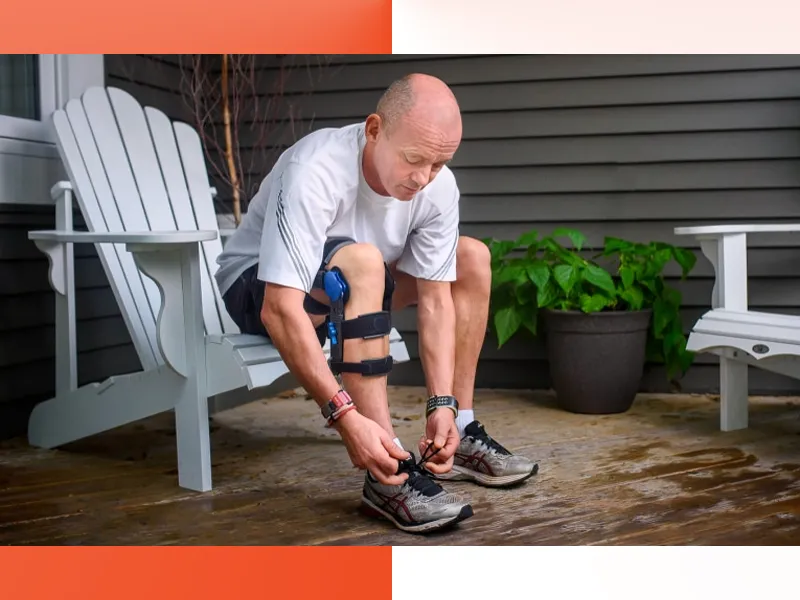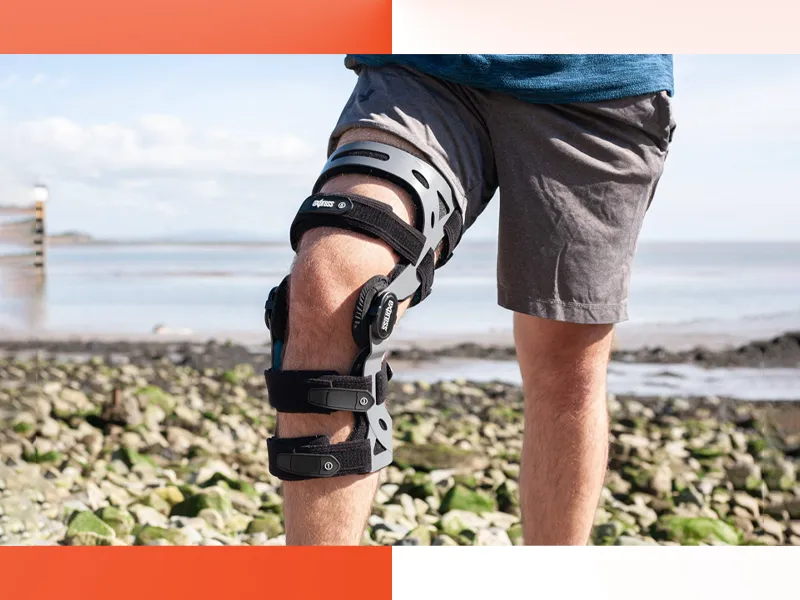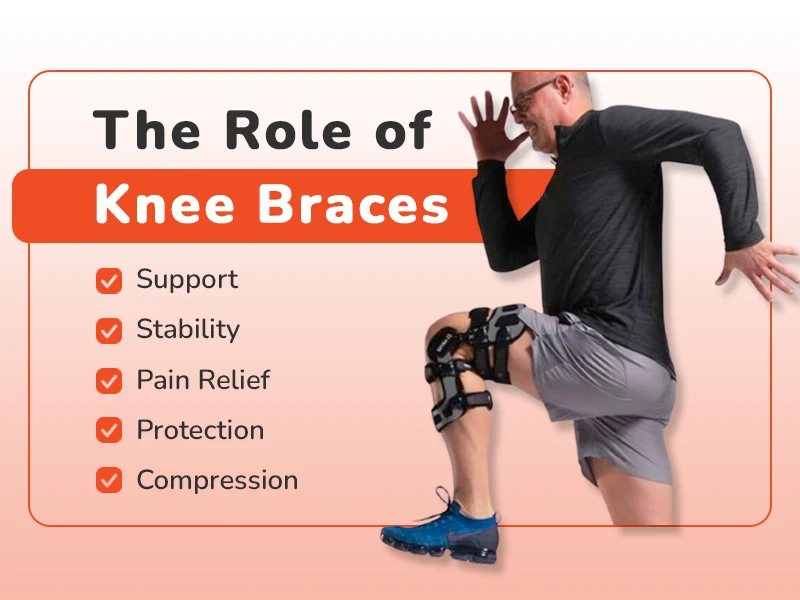Optimizing Mobility: The Benefits of Knee Braces for Active Lifestyles
Maintaining an active lifestyle is essential for overall health and well-being, but it can often lead to joint stress and injuries, particularly around the knee, one of the body’s most complex joints. Knee braces are designed to provide support, ease pain, and prevent further injury, making them vital for athletes and active individuals alike. This blog will explore the various types of knee braces available, their benefits, and provide guidelines on how to choose and use them effectively. Whether you are looking to prevent potential injuries or manage existing conditions, the right knee brace can enhance your mobility and help you maintain an active lifestyle without compromise. Through this guide, you’ll gain the knowledge needed to select a knee brace that best fits your needs and lifestyle, ensuring you stay active and protected.
Understanding Knee Braces
A knee brace is more than just a support garment; it is a crucial tool designed to protect the knee from future injuries or minimize the risk of exacerbating existing conditions. This protection is particularly vital for individuals involved in high-impact sports such as running, basketball, or soccer, where the knees are subjected to great stress and are at a higher risk of injury.
Functionality and Types of Knee Braces
Knee braces come in various designs, each tailored to specific needs and conditions:
- Prophylactic braces: These are used primarily by athletes who participate in high-impact sports to prevent injuries. They are designed to protect the knee from collisions and forceful impacts that commonly occur in sports.
- Functional braces: These braces help support knees that have already been injured. They stabilize the knee and control its motion to prevent further damage while allowing athletes to continue training and competing.
- Rehabilitative braces: These are used to limit harmful knee movements while a knee injury or post-surgical site is healing. They are typically bulkier than other types of braces to provide maximum protection and rigid support.
- Unloader/offloader braces: These are specifically designed for people suffering from arthritis. Unloader braces relieve pain by shifting the weight away from the damaged area of the knee, reducing stress on the knee joint.
Materials and Adjustability
The materials used in knee braces vary from metals and foams to plastic and elastic fabrics, each providing different levels of support and comfort. Most knee braces come with straps or hinges that can be adjusted to fit perfectly, which is crucial for the brace to be effective in stabilizing the knee and preventing injuries.
Importance of Correct Fit
It is essential that a knee brace fits well. A brace that is too tight may restrict blood flow and cause further issues, whereas one that is too loose won’t provide adequate support. Proper fitting braces should feel snug around the knee without cutting off circulation or sliding out of place during activities.
In summary, understanding the different types of knee braces and their specific functions helps individuals, especially those active in sports, to select the right one that best suits their needs. Whether it’s for injury prevention, recovery support, or pain relief, a well-chosen knee brace is a key component in maintaining knee health under the rigorous demands of active lifestyles. This comprehension ensures the knee brace can offer the necessary protection and support where and when it’s most needed, enhancing an individual’s ability to perform and stay active with confidence.
Benefits of Using Knee Braces
Knee braces offer a multitude of benefits that are indispensable for individuals aiming to maintain an active lifestyle while managing knee health. These benefits not only enhance performance but also significantly reduce the risk of injury, providing support in various forms:

- Injury Prevention: One of the primary benefits of knee braces is their ability to prevent injuries. By stabilizing the knee joint and offering compression, these braces maintain proper leg alignment, which is crucial during high-impact activities that can put excessive stress on the knee. The compression helps to support the knee structure, including the ligaments and tendons, reducing the likelihood of overextensions and tears.
- Support and Stability: Knee braces are particularly beneficial for individuals who have previously experienced knee injuries. The additional support provided by braces can reinforce the knee, allowing those recovering from sprains, tears, and other knee-related injuries to participate in activities without fear of re-injury. This support helps maintain proper knee alignment during physical activities, which is vital for the knee’s healing.
- Improved Mobility: Properly supported knees allow for a wider range of motion with reduced pain, which is essential in achieving peak performance in any sport. Whether making quick pivots in basketball, running on uneven terrain, or cycling long distances, knee braces help maintain dynamic knee stability. Enhanced mobility with the support of a knee brace ensures that movements are smooth and controlled.
- Pain Relief and Recovery: Knee braces play a significant role in pain management and recovery. For conditions such as arthritis or meniscal tears, knee braces distribute weight and relieve pressure on the most affected areas of the knee, easing pain significantly. Additionally, for postoperative care, they prevent harmful movements that could complicate the healing process, thus safeguarding the knee from additional stress and facilitating a quicker recovery.
- Confidence in Movement: The psychological benefits of wearing knee braces are profound. Providing reliable support and minimizing pain, braces help boost confidence among users. This increase in confidence can lead to improved performance, as individuals are more likely to engage fully in their activities without the mental burden of fearing injury.
- Enhanced Participation: A knee brace provides pain mitigation and increased support, so individuals can often participate in activities they would otherwise avoid. This benefit is particularly important for seniors or those with chronic knee issues who might be hesitant to engage in any physical activity that could exacerbate their conditions.
By effectively utilising a knee brace, individuals can protect their knees, enhance their mobility, and continue to lead active, fulfilling lives. Whether you are an athlete looking to optimize performance or someone trying to overcome or prevent knee issues, a knee brace can be an excellent addition to your healthcare regimen.
Choosing the Right Knee Brace
Selecting the perfect knee brace is essential to prevent injuries and manage existing conditions effectively. It requires understanding the different needs based on activity type, the specific injuries it needs to support, and ensuring a good fit for comfort and functionality. Here’s how to choose the right knee brace for your needs:

- Activity Type: The intensity and nature of your activities greatly influence the type of knee brace you need. A thicker, padded brace designed to absorb shocks and provide robust support is ideal for high-impact sports like football or basketball. These braces often come with hinges and straps to firmly hold the knee in proper alignment during rapid and repetitive movements. On the other hand, for less strenuous activities such as hiking or walking, a lighter brace offering more flexibility and less bulk might be sufficient. These braces typically provide compression and mild support, which helps stabilise the knee without the extra bulk that could hinder movement.
- Injury Type: The type of knee injury you’re dealing with also dictates the kind of brace that will be most effective. For instance, functional braces are designed to support knees that have suffered from ACL tears, helping to stabilize the knee during recovery. Unloader or offloader braces benefit those with arthritis as they help redistribute the weight around the knee, reducing pain and improving function. It’s essential to match the brace’s design and features with the type of injury to ensure effective support and faster recovery.
- Fit and Comfort: Achieving the right fit is critical; a knee brace that is too tight can impede circulation, potentially causing further damage or discomfort, while a loose brace may fail to provide the necessary support, rendering it ineffective. Ensure that the brace fits snugly around your knee. Many braces come with adjustable straps that help achieve a custom fit. It should feel supportive without cutting off circulation or sliding down during movement.
- Quality and Durability: The materials used in the brace should be durable and capable of withstanding regular use, especially if the brace will be worn frequently. High-quality materials last longer and maintain their elasticity and support over time. Additionally, the brace should be made from breathable fabrics that help manage sweat, particularly during extended use. Look for braces with good stitch quality and strong fastening materials to ensure longevity and functionality.
- Consultation with Professionals: Whenever possible, consult a healthcare provider such as a physiotherapist or an orthopedic specialist. They can provide professional advice based on your specific conditions and requirements. This step is particularly important if you are recovering from a serious injury or surgery.
- Ease of Use: Consider how easy it is to wear and remove the brace. If you have limited mobility or strength, a brace that features simple closures and can be easily adjusted might be the best choice. This makes you more likely to use the brace regularly as prescribed.
By considering these factors carefully, you can choose a knee brace that fits your specific needs and enhances your ability to perform activities with confidence and comfort. Whether you are looking to prevent potential injuries or manage an existing condition, the right knee brace is a key component in maintaining knee health and mobility.
How to Wear Knee Braces
Proper usage of knee braces is essential for them to be effective and provide the intended support and protection. Ensuring a knee brace is worn correctly can significantly enhance its effectiveness and comfort during activities. Here are detailed steps and tips to help you wear knee braces correctly:
- Read the Instructions Carefully: Before wearing a knee brace, it’s crucial to read and understand the manufacturer’s instructions. Different types of braces might have specific requirements for how they should be positioned and secured. These instructions provide the best practices for wearing the brace, maximising its benefits and preventing skin irritation or discomfort.
- Check the Fit: A proper fit is essential for the brace to function correctly. The brace should fit snugly around your knee without being too tight. It should not pinch or leave indentations on your skin. Do a few test movements before engaging in any physical activities to ensure the brace stays in place without sliding down. It should feel secure but not constrictive, allowing for comfortable movement without compromising support.
- Wear During Activities: Knee braces should be worn during any activities that strain the knee joint, particularly high-impact sports or activities that involve a lot of movements, such as twisting or turning. Wearing the brace can help stabilize the knee and distribute stress across the joint more evenly, which helps prevent injury and pain.
- Positioning the Brace: Make sure that the brace is centred over the knee cap with the stabilizers (if included) correctly aligned on either side of the knee. This alignment is crucial for the brace to provide effective support. The straps should be fastened securely but not so tight that they cut off circulation to the rest of your leg.
- Adjusting Straps for Comfort and Support: Once the brace is on, walk around for a few minutes to feel fit and comfortable. Adjust the straps or fastenings to ensure the brace is neither too loose nor too tight. The support should feel even around your knee without pinching or uncomfortable pressure points.
- Check for Mobility: Perform a range of motions to ensure that your movement is not overly restricted by the brace. You should be able to bend and extend your knee comfortably. Further adjustments might be needed if any movement feels restricted or if the brace bunches up.
- Periodic Re-adjustments: As you wear the knee brace throughout your activity, it may stretch slightly, especially if you are sweating a lot. Periodically check the fit and adjust the straps again if necessary to maintain the right level of tightness and support.
- Wearing a Sleeve Underneath: For added comfort, particularly if you are wearing the brace directly against your skin, consider wearing a thin, breathable sleeve under the brace. This can help reduce chafing and keep your skin dry.
Read More: Knee Braces: Support, Stability, and Recovery
After Use Care
- Cleaning: Regular cleaning is essential to maintain the brace’s hygiene and functionality, especially if you wear it frequently or sweat a lot. Follow the cleaning instructions provided by the manufacturer; most braces can be hand-washed with mild soap and lukewarm water.
- Inspection for Wear: Regularly inspect your brace for signs of wear and tear. Check the straps, fasteners, and overall material for any deterioration that can compromise its effectiveness. Replace the brace as needed to ensure it continues to provide the best possible support.
By following these guidelines, you can ensure that your knee brace performs optimally, enhancing your ability to engage in active pursuits safely and comfortably. Proper wear and care of your knee brace extend its life and maximize your investment in maintaining your knee health.
Maintenance of Knee Braces
Proper maintenance ensures that a knee brace provides optimal support, comfort, and longevity. Here are detailed steps and tips for maintaining your knee brace:
Regular Cleaning
- Follow Manufacturer’s Guidelines: Always follow the cleaning instructions provided by the manufacturer. This will help maintain the brace’s material integrity and functionality.
- Washing: Most knee braces can be hand-washed with mild soap in lukewarm water. Avoid using hot water, as this can affect the brace’s elasticity and adhesive parts.
- Drying: Air dry the brace away from direct sunlight and heat sources, as these can degrade the materials over time. Do not use a tumble dryer, as the intense heat can cause the brace to shrink or warp.
Routine Inspection
- Check for Wear and Tear: Regularly inspect the brace for any signs of wear, such as thinning material, frayed straps, loose fittings, or weakened closures. Pay special attention to areas that are under more stress, such as the straps and the area around the knee joint.
- Assess Functionality: Make sure all brace parts, especially moving parts like hinges or dials, function correctly. Lubricate these components if the manufacturer’s guidelines permit to ensure smooth operation.
- Replace if Necessary: If the brace shows significant damage or signs of wear that could compromise its effectiveness, replace it. Using a damaged brace can lead to inadequate support and further injury.
Proper Storage
- Keep It Dry: Store the brace in a cool, dry place when not in use. Moisture can lead to the growth of bacteria and mould, which not only causes odour but can also degrade the material of the brace.
- Maintain Shape: Avoid folding the brace unnecessarily, as this can cause creases and weaken the material structure. Instead, lay it flat or hang it up to keep it in shape.
- Avoid Unnecessary Exposure: Keep the brace away from harsh chemicals and extreme temperatures, which can affect the materials and adhesives used in the brace.
Odor Management
- Use a Fabric Freshener: If odour becomes problematic, fabric freshener can help. Choose a hypoallergenic spray that is safe for fabric use to avoid skin irritations.
- Baking Soda: For a more natural option, sprinkle baking soda on the brace and let it sit overnight before washing it off. Baking soda is excellent for absorbing odours without damaging the fabric.
Regular Adjustments
- Re-adjust Straps and Fasteners: Straps and fasteners may stretch or lose their grip over time. Regularly adjust these components to ensure the brace fits snugly and provides adequate support.
- Check for Stretching: Elastic materials may stretch with regular use. If the brace becomes too loose, it may not provide adequate support.
By following these maintenance tips, you can significantly extend the life of your knee brace and ensure it remains effective and comfortable. Regular cleaning and inspections will help prevent complications such as skin irritations or further injuries due to inadequate support. Properly maintained, a knee brace is valuable for anyone looking to protect their knees and maintain an active lifestyle.
Conclusion: Enhancing Active Lifestyles
Knee braces are a valuable tool for anyone wanting to maintain an active lifestyle while managing knee health. By understanding the different types of braces and their appropriate uses, athletes and active individuals can choose the best knee brace to enhance their mobility and protect against injuries. Embracing the use of knee braces as part of a proactive approach to knee health can help you stay active, perform better, and enjoy a higher quality of life. Choose the right knee brace today and take a positive step towards a healthier, more active tomorrow.






